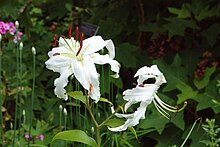Lilium speciosum
| Lilium speciosum | |
|---|---|

| |
| A white cultivar | |
| Scientific classification | |
| Kingdom: | |
| (unranked): | |
| (unranked): | |
| Order: | |
| Family: | |
| Genus: | |
| Species: | L. speciosum
|
| Binomial name | |
| Lilium speciosum | |
| Synonyms[1] | |
|
Synonymy
| |
Lilium speciosum is an East Asian species of plants in the lily family. It is native to southern Japan and southern China, where it can be found at elevations of 600–900 metres (2,000–3,000 ft).[1][2][3] It is sometimes called the Japanese lily though there are other species with this common name.
Lilium speciosum grows up to 1.2 metres (3 ft 11 in) tall and 0.3 metres (1 ft 0 in) wide, blooming from August to September in north temperate regions.[4] The flowers are white to pink in colour, and strongly scented. It is later flowering than most other species. Many garden forms are in cultivation, and the species has been widely used for breeding of garden forms.
Lilium speciosum contains phenolic glycosides, such as 6′-O-feruloylsucrose and (25R,26R)-26-methoxyspirost-5-en-3β-ol 3-O-α-l-rhamnopyranosyl-(1→2)-β-d-glucopyranoside, and steroidal saponins.[5]
- Varieties[1]
- Lilium speciosum var. gloriosoides Baker - China, Taiwan
- Lilium speciosum var. speciosum - Japan (Shikoku, Kyushu)
-
1870 illustration[6]
Toxicity
Lily pollen is toxic to domestic cats and ingestion is often fatal;[7][8][9] households and gardens which are visited by cats are advised against growing lilies or placing lily flowers where a cat may brush against them and become dusted with pollen, which they then consume while cleaning.[10] Suspected cases require urgent veterinary attention.[11] Prompt treatment with activated charcoal and/or induced vomiting can reduce the amount of toxin absorbed, and large amounts of fluid by IV can reduce damage to kidneys to increase the chances of survival.[11]
References
- ^ a b c Kew World Checklist of Selected Plant Families
- ^ Tropicos, Lilium speciosum Thunb.
- ^ Flora of China Vol. 24 Page 142 药百合 yao bai he Lilium speciosum var. gloriosoides Baker, Gard. Chron., n.s.,. 14: 198. 1880.
- ^ "Lilium speciosum". Plants for a Future. Retrieved September 9, 2013.
- ^ Yoshihiro Mimaki and Yutaka Sashida (1991). Steroidal and phenolic constituents of Lilium speciosum. Vol. 30. Phytochemistry. pp. 937–940. doi:10.1016/0031-9422(91)85283-6.
- ^ Image from "Flora Japonica" by Philipp Franz von Siebold and Joseph Gerhard Zuccarini
- ^ Frequently Asked Questions No Lilies For Cats.
- ^ Fitzgerald, KT (2010). "Lily toxicity in the cat". Top Companion Anim Med. 25: 213–7. doi:10.1053/j.tcam.2010.09.006. PMID 21147474.
- ^ Which lilies are toxic to cats? Your Cat.
- ^ The Valentine bouquet that killed my cats: Mother's Day warning on lethal lilies Daily Mail.
- ^ a b Lily Poisoning in Cats. Pet MD.
External links
- Dave's Garden plantfile
- Heritage Perennials plant profile in English with photo
- Pacific Bulb Society, Lilium Oriental Section photos of flowers and bulbs of several species

![1870 illustration[6]](http://upload.wikimedia.org/wikipedia/commons/thumb/7/79/Lilium_longiflorum_SZ12.png/90px-Lilium_longiflorum_SZ12.png)